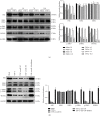Effect of MicroRNA-138 on Tumor Necrosis Factor-Alpha-Induced Suppression of Osteogenic Differentiation of Dental Pulp Stem Cells and Underlying Mechanism
- PMID: 35845957
- PMCID: PMC9286885
- DOI: 10.1155/2022/7230167
Effect of MicroRNA-138 on Tumor Necrosis Factor-Alpha-Induced Suppression of Osteogenic Differentiation of Dental Pulp Stem Cells and Underlying Mechanism
Abstract
High doses of tumor necrosis factor-α (TNF-α) suppress osteogenic differentiation of human dental pulp stem cells (hDPSCs). In the present study, we aimed to explore the role and potential regulatory mechanism of microRNA-138 (miR-138) in the osteogenic differentiation of hDPSCs after treatment with a high dose of TNF-α. The hDPSCs were cultured in osteogenic medium with or without 50 ng/ml TNF-α. The miR-138 levels were upregulated during osteogenic differentiation of the hDPSCs following TNF-α treatment. The miR-138 overexpression accelerated but miR-138 knockdown alleviated the TNF-α-induced suppression of the alkaline phosphatase activity, calcium deposition, and protein abundance of dentin sialophosphoprotein, dentin matrix protein 1, bone sialoprotein, and osteopontin during osteogenic differentiation induction of hDPSCs. Additionally, miR-138 overexpression accelerated but miR-138 knockdown alleviated the suppression of the focal adhesion kinase- (FAK-) extracellular signal-regulated kinase 1/2 (ERK1/2) signaling pathway during osteogenic differentiation induction of hDPSCs under TNF-α treatment. In conclusion, miR-138 accelerates TNF-α-induced suppression of osteogenic differentiation of hDPSCs. Inactivation of the FAK-ERK1/2 signaling pathway may be one of the mechanisms underlying the effect of miR-138. Inhibition of miR-138 expression may be a strategy to weaken the inhibitory effect of high-dose TNF-α on the osteogenic differentiation of hDPSCs.
Copyright © 2022 Wenzhe Liu et al.
Conflict of interest statement
The authors declare no competing interests associated with the manuscript.
Figures




Similar articles
-
SNHG7 promotes the osteo/dentinogenic differentiation ability of human dental pulp stem cells by interacting with hsa-miR-6512-3p in an inflammatory microenvironment.Biochem Biophys Res Commun. 2021 Dec 3;581:46-52. doi: 10.1016/j.bbrc.2021.09.081. Epub 2021 Oct 2. Biochem Biophys Res Commun. 2021. PMID: 34653678
-
miR-342-5p inhibits odonto/osteogenic differentiation of human dental pulp stem cells via targeting Wnt7b.Oral Dis. 2023 Jul;29(5):2107-2116. doi: 10.1111/odi.14195. Epub 2022 Apr 19. Oral Dis. 2023. PMID: 35322903
-
Long Noncoding RNA MIR4435-2HG is Involved in Osteogenic Differentiation and Inflammation in Human Dental Pulp Stem Cells.Int Dent J. 2025 Aug;75(4):100866. doi: 10.1016/j.identj.2025.100866. Epub 2025 Jun 25. Int Dent J. 2025. PMID: 40570674 Free PMC article.
-
Dysregulation of lncRNA TFAP2A-AS1 is involved in the pathogenesis of pulpitis by the regulation of microRNA-32-5p.Immun Inflamm Dis. 2024 Sep;12(9):e1312. doi: 10.1002/iid3.1312. Immun Inflamm Dis. 2024. PMID: 39254474 Free PMC article.
-
miR-20a-5p contributes to osteogenic differentiation of human dental pulp stem cells by regulating BAMBI and activating the phosphorylation of Smad5 and p38.Stem Cell Res Ther. 2021 Jul 22;12(1):421. doi: 10.1186/s13287-021-02501-8. Stem Cell Res Ther. 2021. PMID: 34294156 Free PMC article.
Cited by
-
MicroRNA-138: an emerging regulator of skeletal development, homeostasis, and disease.Am J Physiol Cell Physiol. 2023 Dec 1;325(6):C1387-C1400. doi: 10.1152/ajpcell.00382.2023. Epub 2023 Oct 16. Am J Physiol Cell Physiol. 2023. PMID: 37842749 Free PMC article. Review.
-
Potential of Dental Pulp Stem Cell Exosomes: Unveiling miRNA-Driven Regenerative Mechanisms.Int Dent J. 2025 Apr;75(2):415-425. doi: 10.1016/j.identj.2024.08.019. Epub 2024 Oct 5. Int Dent J. 2025. PMID: 39368923 Free PMC article. Review.
References
MeSH terms
Substances
LinkOut - more resources
Full Text Sources
Research Materials
Miscellaneous

